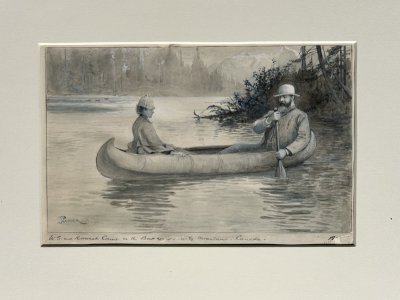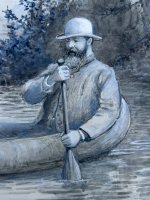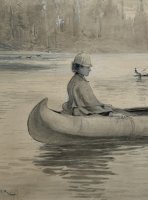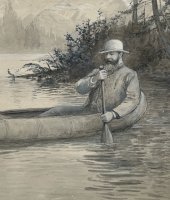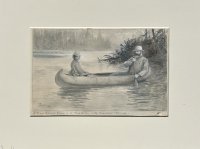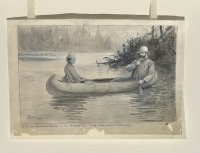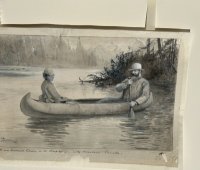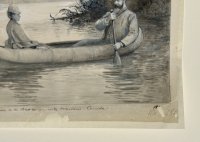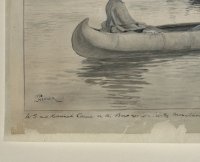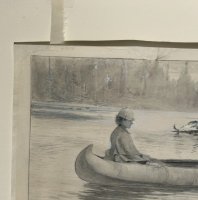Shadowrock Rare Books
John PEDDER RI, RBC (1850-1929, artist).
“W.S. and Hannah Caine on the Bow River - Rocky Mountains – Canada”
a tarific image in the Canadian Rockies
$300
Item Details
[Maidenhead, Berkshire, England], [c. 1888]
laid down, light damage
John PEDDER RI, RBC (1850-1929, artist).
“W.S. and Hannah Caine on the Bow River - Rocky Mountains – Canada” [titled in the published version “On the Bow River, Banff”, being a double-portrait of William Sproston Caine (1842-1903) and his daughter Hannah in a birch-bark canoe: William paddles, Hannah sits facing him in the bow]. [U.K.: undated but 1888 or earlier]. Ink and grey wash on paper (image area: 6 7/8 x 11 ¼ inches), signed in the image by the artist, titled in ink beneath the image, backed onto Japanese tissue (some small areas of damage and loss [see images]).
The original artwork to the full-page illustration on p.81. of W.S. Caine’s ‘A Trip Round the World in 1887-8’ (London, Glasgow & New York: George Routledge & Sons, 1888).
The author, William Sproston Caine (1842–1903), was a British politician, specifically a Liberal Unionist Member of Parliament, as well as an advocate for temperance and social reform. The book documents a global journey made from the United Kingdom to Canada, then through Asia—including Japan, Hong Kong, Singapore, Ceylon (now Sri Lanka), and India—before returning to the UK. The work is presented as a collection of letters and memories, richly illustrated by Caine himself along with John Pedder and Henry Sheppard Dale.
Caine acknowledged Pedder’s contribution to the book in his Preface: “I wish to acknowledge gratefully the assistance I have had from my old friend, Mr. John Pedder, of Maidenhead, who has evolved the greater portion of the illustrations, with accuracy and artistic skill, from a heterogeneous collection of rough sketches and photographs made by me on my journey.”
Lytham St. Anne’s Art Collection biographical note: “John Pedder, who was born in Liverpool in 1850, was a landscape artist who painted chiefly in watercolour. On his marriage, in 1883, he moved to London and finally settled in Eastfield, Burge Place, Maidenhead.
Pedder was a friend of George Clausen (1852-1944), who influenced his style. (Bennet, 1978) Clausen started painting rural naturalist subjects plein-air (outside) from 1880, in imitation of the French painter, Jules Bastien-Lepage (1848-1884). Clausen met Bastien-Lepage and like many others became a devoted follower. He wrote ‘Jules Bastien-Lepage As Artist’, c1892, which was published in Andre Theuriet’s book ‘Jules Bastien-Lepage and His Art, A Memoir’. Clausen was also a founder member of the ‘New English Art Club’, who painted rustic subjects and, like Pedder, moved strongly into watercolours.
Pedder attended the Liverpool School of Art and was elected as a member of Liverpool Academy in 1874; at that time he offered tuition (AB, 2014) but later resigned. (RBC, 1920).
From 1877 to 1882 he was a member and Honorary Secretary of the Liverpool Society of Painters in Watercolours and in 1898 became a member of the Royal Institute of Painters in Watercolours. (RI).
In 1910 Pedder became a member of the Royal British Colonial Society of Artists (RBC), formed in 1886 for the purpose of holding exhibitions in the colonies. Founder members were William Ayerst Ingram (1855-1913) and Thomas Cooper Gotch (1854–1931), painter and book illustrator. (AB, 2014) Many RBC members were recognised as part of the Newlyn School of painters; Ingram was a founder member and Gotch was a leading figure. However, Gotch soon abandoned rural realist narrative painting for a more stylised Pre-Raphaelite approach.
In 1904 the scope of the RBC was enlarged to include all the British Possessions and Dependencies and the present title received Royal sanction (previously Royal Anglo Australian Society of Artists). As its title suggests, many artists from the then British colonies of South Africa, Canada, India, New Zealand and Australia also exhibited. British Percy Craft (1856-1934), also of the Newlyn School, was particularly active in the organisation of exhibitions for the Royal British Colonial Society of Artists. The last exhibition appears to have been staged in 1937 at the galleries of the Royal Institute, then located at 712 Suffolk Street, Piccadilly, London.
Pedder was not a member of the Royal Academy but often exhibited there. It is recorded that in 1901 he wrote to the secretary of the Royal Academy, F A Eaton, thanking him for informing him that his picture, The Lame Foot, had been selected for the National Gallery of Victoria, Melbourne. (RA, 1901) This painting was still in their collection in 1930. (NVG, 1930).
Pedder also illustrated a book by William Sproston Caine (1842-1903), ‘A Trip Around the World in 1887-8’, published by London Routledge in 1888. The original illustrations were in watercolour and ink with touches of gouache on paper. Gouache, also spelt guache, is a type of paint consisting of pigment and gum, usually gum Arabic. Caine was a British politician and ‘temperance advocate’ who travelled around the world with his daughter, Hannah, between March 1886 and August 1887. During the Victorian period the temperance movement became more radical, advocating the legal prohibition of all alcohol rather than just calling for moderation. It was also perceived to be tied in with both religious renewal and progressive politics.
Caine's numerous sketches and photographs, taken during the journey, were used as illustrations to his book, some in the original state and some being reworked 'by my old friend, Mr John Pedder of Maidenhead, who has evolved the greater portion of the illustrations, with accuracy and artistic skill'. (Caine,1887)”
Shadowrock Rare Books
Adam Langlands
27 Cleveland St
Lakeville, Ct, 06039
United States
Phone: 8602481547
Cell: 8602481547
Featured Catalogue
Visit Website
Specialities
Nat. History, Bindings, Association copies
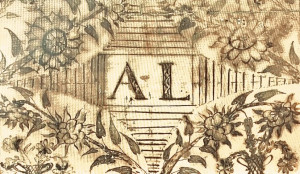
More Information
Booth 34
Shipping and Returns
Shipping will always be at cost. Items are returnable for any reason within a reasonable period of time - we will refund the purchase price, but ask that the buyer pays for the shipping.
Open Times
By AppointmentAdditional Information
Shadowrock Rare Books (https://shadowrockrarebooks.com/): a relatively new multi-faceted book business by a relatively old bookman. Starting in the 1970s, Adam Langlands has worked for most of the great auction houses, and been associated with a number of the greatest dealers. He has examined, researched and catalogued a huge range of books representing many subjects, languages, techniques, dates and price-points: from 'Sky-Hi A trip into space with Terry' (1952, kid's transformational book) to the Fox/Bute copy of Audubon's 'Double-Elephant Folio' (sold at auction for $8,802,500). Inspired by their recent move to a home which previously belonged to both George Simenon (of Maigret fame) and Seymour Hacker (founder of Hacker Art Books), Adam and Susu Langlands have decided to continue the literary connection and set up Shadowrock Rare Books. Today's global online marketplace means that there is a danger that the call of the unique will get drowned out by the cries of the banal: it is the mission of Shadowrock Rare Books to rescue and highlight these gems. Joining Getman’s Virtual Book & Paper Fairs was an obvious next step for us – we have cheered him on from the sidelines from the beginning!
